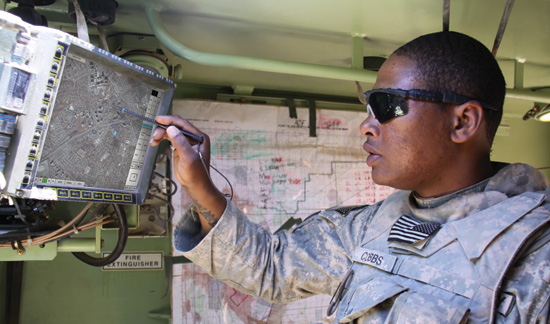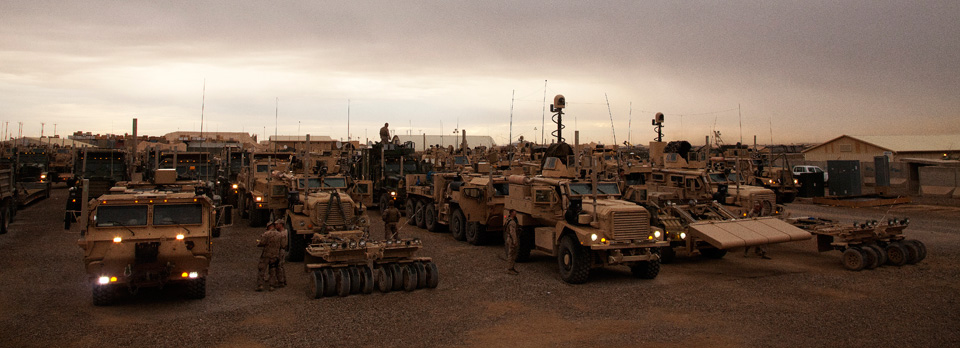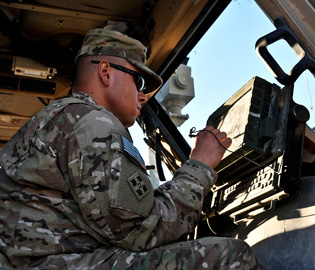
The US Army is finally integrating a blue-force tracking system common to manoeuvre and logistics elements. Defense-Update reports. For the first time on the battlefield, maneuver and logistics forces will be able to share situational awareness and messaging, forming a complete and seamless operational picture. This essential capability was not feasible in the past, as the combat and support levels in the brigade combat team employed separate and incompatible communications networks that could not exchange information in real time. The new capability was delivered by integrating the vehicle-based Movement Tracking System (MTS) into the Army’s upgraded friendly force tracking system known as ‘Joint Capabilities Release’ (JCR), the latest addition to the Force XXI Battle Command Brigade and Below /Blue Force Tracking (FBCB2/BFT) system. That systems provides two-way situational awareness and message exchange between convoys and the maneuver formations they are supporting in the combat zone. “Before, MTS was a standalone network and separate software baseline. Now, logistics get the same mapping capability, the same operational picture and they pick up the same message sets as maneuver forces.” said Lt. Col. Bryan “BJ” Stephens, product manager Blue Force Tracking for the Army’s Program Manager (PM) Joint Battle Command-Platform, (JBC-P). “On top of that, we’ve consolidated two field support processes, two training elements and two fielding teams into one operation.”

Besides improving situational awareness and minimizing risks of fratricide, the new tool will also streamline the logistical supply service offering more streamlined delivery and coordination, avoiding navigation errors and scheduling timely and precise meeting points.
JCR Logistics builds on the technology Soldiers have relied on for situational awareness in Iraq and Afghanistan, FBCB2/BFT has been integrated on more than 120,000 platforms and authorized or fielded to every brigade combat team in the Army. Primarily used in military vehicles, FBCB2’s display screen shows blue and red icons over a geospatial imagery map. It paints a complete picture of the battlefield – including friendly and enemy forces, as well as terrain hazards — enabling units to synchronize operations and avoid friendly fire incidents. The JCR upgrade, developed by program integrator Northrop Grumman is the first of two planned upgrades, brought faster satellite network delivered by ViaSat and Type 1 secure data encryption, as well as the improved capabilities to logistics platforms.
The MTS system based on hardware and systems provided by Comtech, was designed to track logistics formations, included a Radio Frequency Identification, or RFID, capability to provide in-transit, near-real time visibility of critical cargo. By integrating MTS into JCR Logistics, users can communicate with and track maneuver and logistics platforms together, enabling the safe and timely completion of distribution missions in support of full spectrum operations.
The new, integrated capability introduced with the logistics formations is known as ‘JCR Logistics’. Logistics vehicles including freight haulers, Heavy Expanded Mobility Tactical Trucks, or HEMTTs, and fuel tankers that transport goods on the battlefield to feed, fuel and arm maneuver formations will now be equipped with JCR Logistics. JCR installation into logistics supporting platforms in Afghanistan was completed in March 2013. “The fielding to Afghanistan is a major step forward,” said Col. Michael Thurston, project manager for JBC-P. “This is laying the groundwork for CS 13 and getting an important capability into the hands of our Soldiers.”
CS 13 is the Army’s first integrated communications package that spans the entire brigade combat team, or BCT, formation, connecting the fixed tactical operations center to the commander on-the-move to the dismounted Soldier. CS 13, which includes JCR, is comprised of networked vehicles, radios, satellite systems, software applications, hand held devices and other network components, integrated and vetted by Soldiers through the Network Integration Evaluation (NIE) process. Two BCTs of the 10th Mountain Division are currently training on the capability set in preparation for deployment later this year. “Instead of having to run back to the vehicle or wait for grid coordinates, I can look down, see where (my Soldiers) are at and be able to make a decision of where to deploy them on the battlefield,” said 1st Lt. Jason Kruger, 2nd Brigade, 1st Armored Division, who used the new technologies during the Army’s most recent NIE 13.1. By combining blue force tracking technology with the handhelds, it provided “situational awareness anywhere you go.”
“This is a game-changer,” said Thane C. St. Clair, chief of Product/Capabilities Distribution for PM JBC-P. “Before, MTS was a stand-alone system, using a separate network and different protocols that prevented the sharing of information. Now, JCR-equipped systems can communicate with and track maneuver and logistics platforms together for seamless situational awareness.”
With JCR Logistics, Soldiers have improved visualization across the network, with the ability to locate and track not only friendly forces and the enemy, but also combat support and combat service support vehicles delivering necessary supplies.
The integration came as part of a streamlining of the two C3 networks that began in 2006, under the Department of the Army directive to phase out the MTS as a separate program, thus consolidating the two networks under one management eliminated separate program management, contracts, satellite channels and operation elements which effectively duplicated costs. The directives greatly improved capabilities and interoperability provided to both MTS and FBCB2/BFT users. According to Army estimates, the merging of the two programs saved about $20 million by avoiding redundant expenses. By 2016 it is expected to save additional $120 million.
The JCR upgrade, developed largely based on Soldier feedback, introduces JCR-Logistics, which integrates JCR capability with the Movement Tracking System (MTS), resulting in a seamless, two-way situational awareness and message exchange between convoys and the maneuver formations to which they are delivering goods. JCR also utilizes the BFT 2 network, a new satellite infrastructure that can handle significantly more data than the first BFT. This capacity increase allows for more frequent and larger message traffic, and in many cases cuts the system’s refresh rate from minutes to seconds. Since October 2012, PM JBC-P has fielded or upgraded a total of 275 JCR platforms and 32 JCR Tactical Operation Center (TOC) Kits in Afghanistan. Also, a total of 242 JCR-Logistics platforms and 34 JCR-Logistics control stations have been upgraded.
The next step in the JCR upgrade is upgrade currently in testing, is the JBC-P, a battle command network that offers enhanced blue force tracking capabilities through a modern, more intuitive user interface featuring contemporary ‘touch’ gestures common in tablets and smartphones, like touch-to-zoom maps and drag-and-drop icons. The upgrade brings enhanced data encryption, improved maps, better collaboration tools and more precise location information for vehicles, aircraft and dismounted Soldiers.
Source: Defense-Update




















